How Muslims set foot to Hong Kong
Before the Island of Hong Kong was ceded to Britain by the Viceroy at Canton (Guangzhou) in January 1841, Hong Kong was a tiny part of San On District of Kwan Tung Province. At that time the population of the Island was only about five thousand (as compared with 5.3 million today) consisting mostly of farmers and their families living in the valleys, and fishermen living on boats along the sheltered coast.
The first British ships to sail into the Chinese waters were those of East India Company (where most of the crew were recruited) from Calcutta in India for trading between the various posts from India to Japan. The East India Company's trade with China reached its peak in the early 19th century and seamen were then mostly signed on from Bombay and Calcutta by the British first opium clipper which was then a wooden boat known as "Red River," built by Jardine & Matheson in Calcutta in 1829. Since then it had opened the gate for the early Muslims settling down in Hong Kong.
Hong Kong means "Fragrant Harbour" and the early seamen mostly came from the shores of Malabar (India), Bay of Bengal, Campbellpur (Attock), Hazara (Abbottabad), Lahore, and Gujarat. Besides those others came from Shanghai, Aden (Yemen), Java, Sumatra, Malacca, Malaya (now Malaysia), Sarawak, South-Sea Borneo, Brunei, Port Said (Egypt), Turkey, Zanzibar (Tanzania).
With Hong Kong beginning to develop into an important seaport for the British, more and more seamen and garrisons were passing through and some settled here, like Chinese Turkestan, Burmese, Ceylonese, Indo-Chinese, white Russians from both Russia and Harbin, Moros from the South Philippines and Arabs etc.
During the early 19th century many Muslim seamen had no proper accommodation or dormitory but somehow or other they managed to stay well-knitted together in an area known as Lower Lascar Row - in the Central area, better known to the Hong Kong old timers as "Moro Kai" (streets of the people of the Moros). The Muslim seamen held their first Jamat (gathering) in an open street at Lower Lascar Row, and continued to do so for a time. In those days the non-Muslims never dared to pass through that street after marketing for fear of hurting the Muslims' feeling when they held pork and walked along while the Muslims were having their "Salat." Years later with hundreds of the Muslims and their families having vacated their shops and residences for elsewhere in Hong Kong, their shops were taken over by Chinese traders selling Curios, Old Scrolls and Relics and these streets of Lower Lascar Row are now better known to many tourists as the "Cat Street."
With Hong Kong already well established under Britannia more and more Muslims were heading this way from India (principally Punjabis) filling most of the post as Hong Kong Police Constables, Marine Guards, Prison Guards, Dockyard Guards, Watchmen, Bank Clerks, Royal Naval Dockyard Police, Ferry Supervisors, Post Office Mail Launch Guards, Sanitary Foremen and Government Drivers.
As more Muslim garrisons stationing here the Islamic Culture had spread and the whole Muslim community began to form bodies to represent the various sections of the Muslim Society. It was then that the 'Board' of Trustees was formed, and has since been an official body recognized by the Hong Kong Government in the early 20th Century.
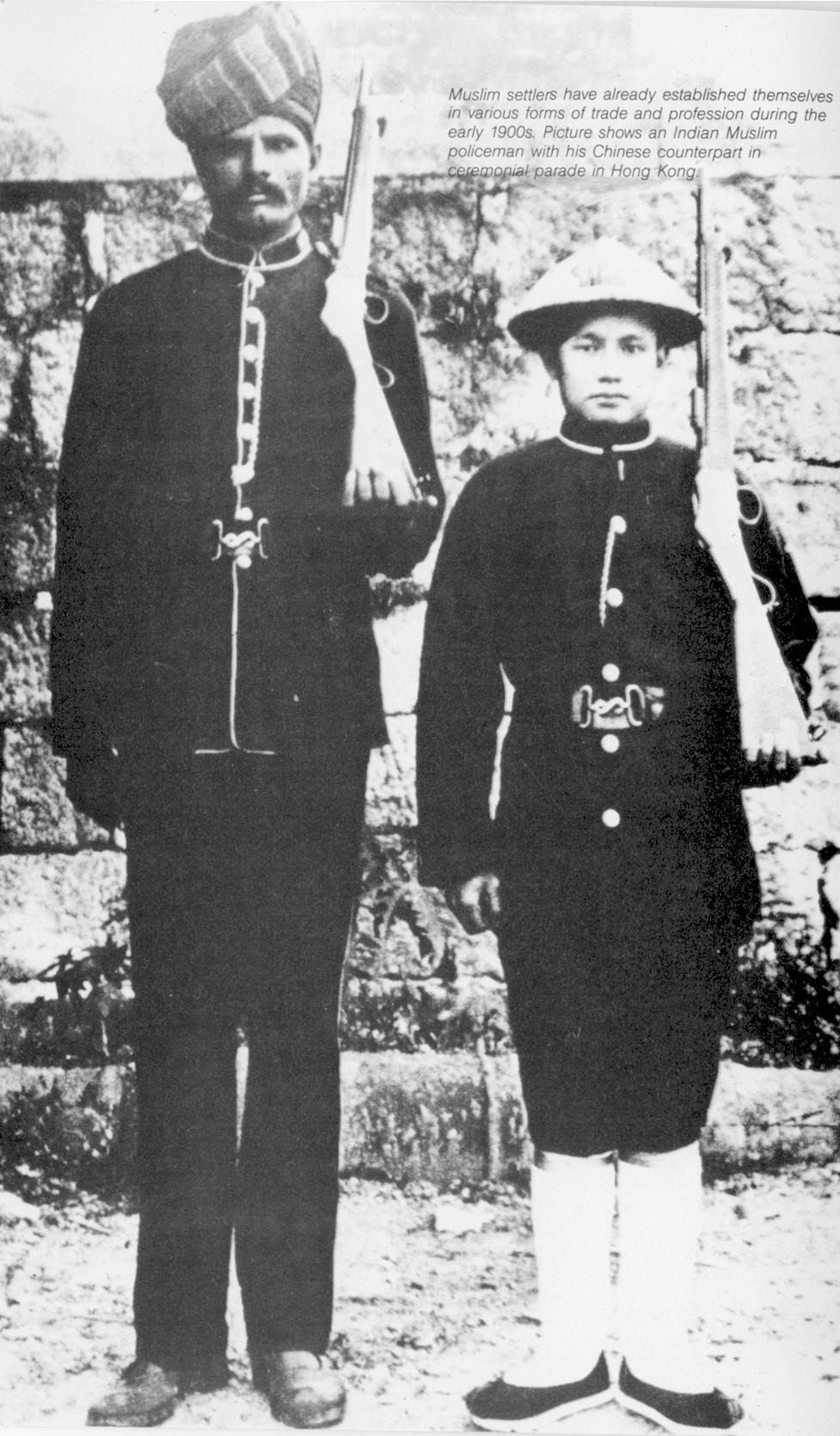
The Muslim garrison was in fact one of the early pioneers in arranging a place for "Salat" (worship) while stationing in Kowloon Peninsula, for they requested their superior commanders for a site large enough to hold gatherings of several hundred worshippers especially for the "Eid" and "Juma" prayers, and that request was granted to them with a temporary site allotted inside the Whitfield Army Barracks between Austin Road and Nathan Road.
After six years the first Mosque in the Kowloon Peninsula was built in 1896. The grand Moorish type Mosque was built entirely by the Muslim garrisons with assistance from their respective commanders.
Besides the Mosque the garrisons also constructed a large concrete pool for storing up water for worshippers to make "Wudhu," and water plants and large gold fish were put inside the pool to prevent the water from pollution. Quarters were also erected for the Maulvi and Mussafir Khana (Rest House for wayfarers). The Muslim garrisons also brought their own Maulvi from Campbellpur (Attock) in Pakistan
The Muslim garrisons ventured further and took another giant step forward by requesting their Commanding Officers for a burial ground in the Kowloon Peninsula for the Muslims who passed away while stationed in Hong Kong. The request was also granted and a temporary site was given to them at Homantin Hill (just behind the present Pui Ching School in Waterloo Road. Every Sunday, the Muslim volunteers would, join forces and develop the area fit for burial. A small Mosque was also built to conduct the "Janaza" prayer. Besides they also managed to dig a well for water to wash the "Miyat" (dead body) and for domestic purposes. The yield of the well water had attracted many residents of the whole Homantin flocking to the Mosque & Cemetery to obtain the water from the well. They named the Mosque & Cemetery "Mora Garden" for its beautiful surroundings and the fresh and cool water from the well.
At the same time, Muslims on Hong Kong island spear-headed by the 'Board of Trustees' began to gather strength to build a Mosque in the mid-level area and a piece of land was leased by the Hong Kong Government for them to build a Mosque at No. 30, Shelley Street. In 1890 the Mosque was built by contributions from only a handful of worshippers and was named "Mohammedan Mosque." In 1905 the Shelley Street Mosque was re-built to a much larger Mosque. After World War II the name was changed to "Jamia Masjid" by the 'Board of Trustees.'
In addition to the area on which the large Mosque was built, there were also three garden plots surrounding the area and special quarters were provided for the Maulvi, Mussafir Khana, "Yatim Khana" (home for the widows and orphans), as well as places for Wudhu and changing room for worshippers.
Hong Kong has now over 30,000 Muslims consisting of various nationalities but with one aim -- to strive for the better the future of our Muslim Community in both unity and understanding. HOLD FAST UNTO THE ROPE OF ALLAH is our motto.
With Allah Taala's Mercy and Guidance, we hope Insha-Allah to live like a Muslim and die like one. Ameen.
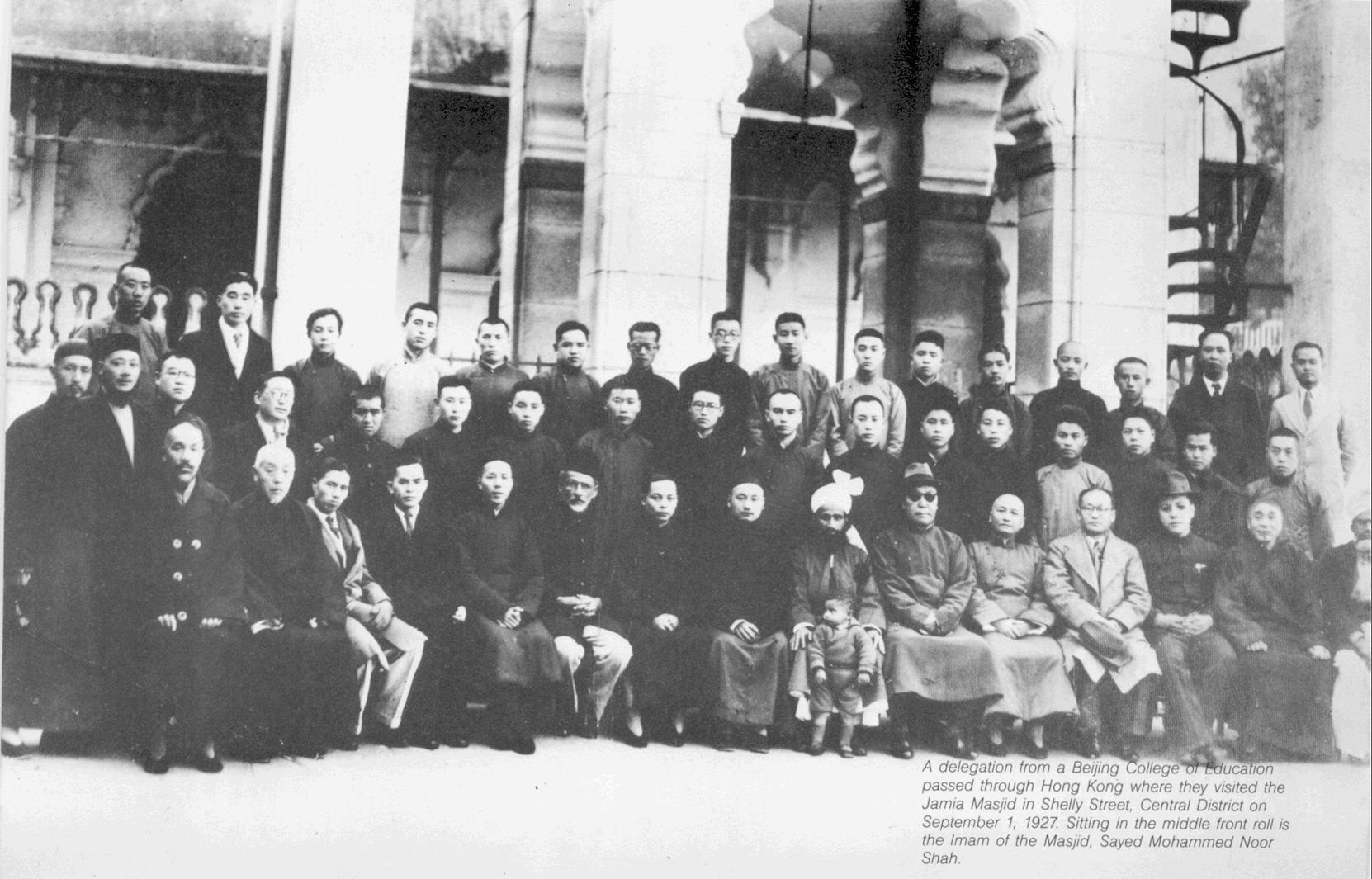
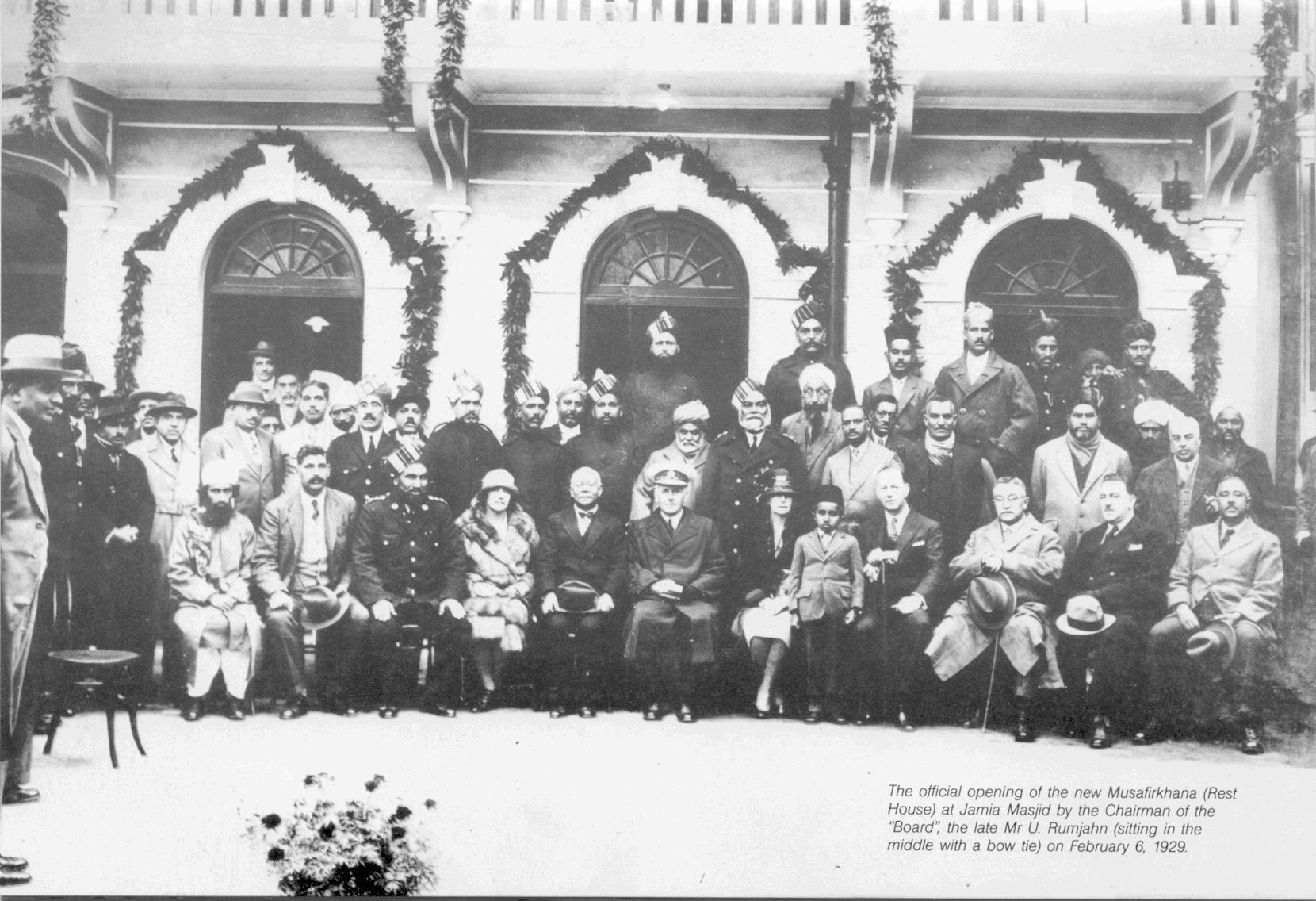
The Incorporated Trustees of the Islamic Community Fund of Hong Kong
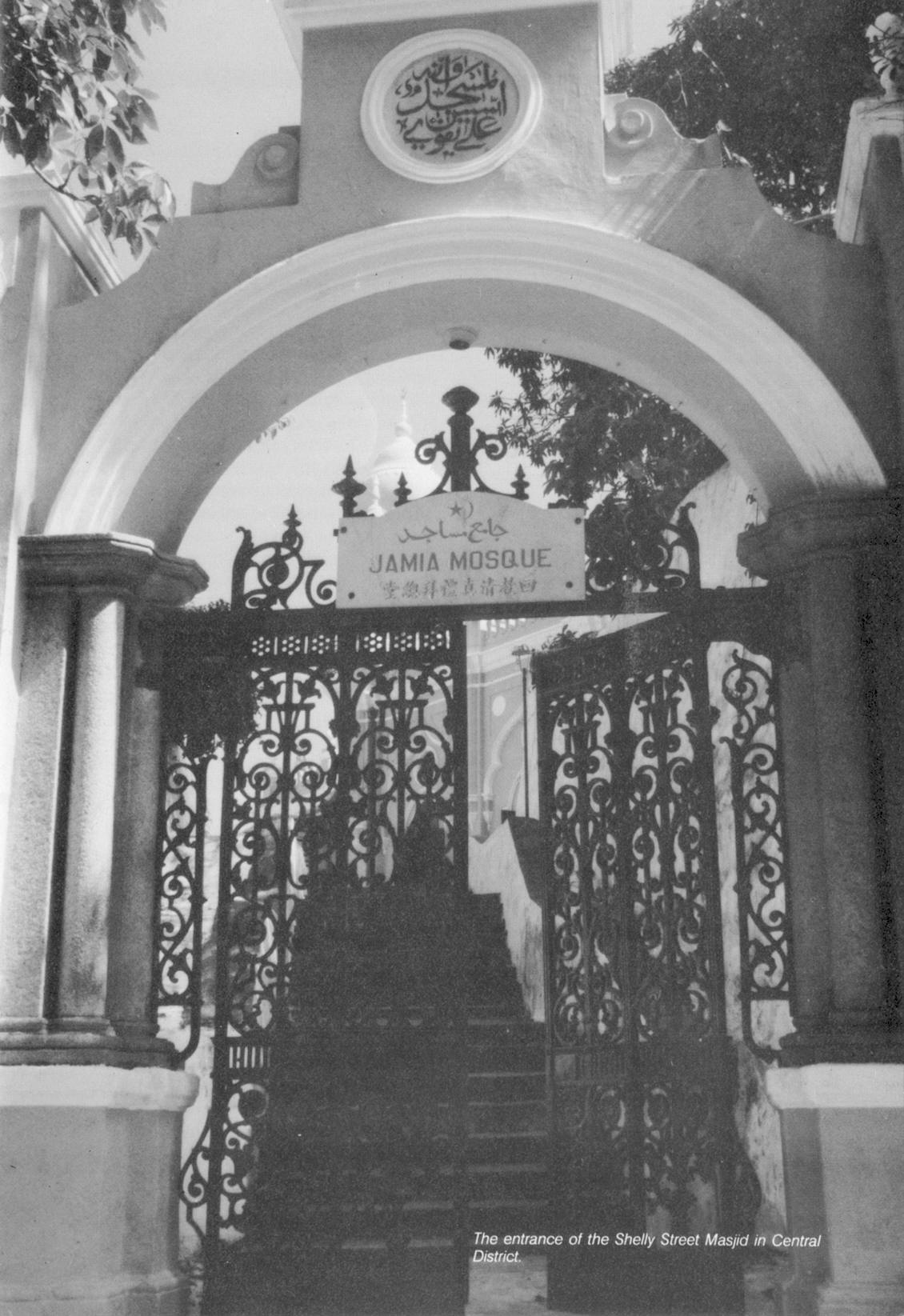
The Government of Hong Kong recognizes only one body as representing the interests of the Muslim Community in Hong Kong for Mosques and Cemeteries. This body is called "The Incorporated Trustees of the Islamic Community Fund of Hong Kong" but is generally known among Hong Kong Muslims as "The Board of Trustees."
Those national Muslim associations or sectarian bodies which are affiliated to the 'Board' and also contribute regularly towards its fund are entitled to nominate representatives on the 'Board.' These nominees elect a Chairman, an Hon. Secretary, and an Hon. Treasurer from amongst themselves.
The main functions of the 'Board' are:
a) To manage the Mosques and Muslim cemeteries in Hong Kong.
b) To control the subscribed, donated and bequeathed funds.
c) To make all arrangements for funerals and burials of deceased Muslims.
d) To organize prayers for special occasions like the Eid festivals.
e) To undertake any other actions in the general interests of the Hong Kong Muslims and propagation of Islam.
Three Mosques on Hong Kong Island (Shelley Street, Masjid Ammar and Cape Collinson) and one Mosque on the Kowloon Peninsula (known as the Kowloon Mosque) are under the jurisdiction of the 'Board.' In addition to the four Mosques, two cemeteries (Happy Valley and Cape Collinson) are under the 'Board's' jurisdiction The following Hong Kong Muslim bodies are affiliated to the Board:
a) The Islamic Union of Hong Kong.
b) The Pakistan Association of Hong Kong, Ltd.
c) The Hong Kong Dawoodi Bohra Association.
d) Indian Muslim Association (JAMAATH) Ltd.
The above four constituent bodies regularly donate funds to the Board, calculated on the number of their members.
It has under the auspicious of the Board that the Kowloon Mosque and Islamic Centre was funded, planned and constructed in 1984 at the total cost of HK$25 million. It is a matter of humble pride to the Muslim Community of Hong Kong that their unified effort has resulted in this magnificent Mosque a symbol of Muslim presence in Hong Kong amidst the most commercial part of the Kowloon Peninsula known as Tsim Sha Tsui.
Everyday and especially on Fridays the call of the Muezzin is heard by the believers in the turning surrounding shops and offices of Tsim Sha Tsui and Muslims lay aside their daily task of earning their bread and flock to the Mosque and join their brothers of many nationalities in saying "Allaho Akbar."
Islamic Union of Hong Kong
The Islamic Union of Hong Kong was founded some 80 years ago by Muslims from the Indian Subcontinent and the Malay Archipelago whose primary purpose for coming here was to enter into trade and commerce with China. Because of their enthusiastic spirit, they finally settled in Hong Kong to pursue their trading activities.
Since its establishment as an institution, the Islamic Union has undergone many changes, the last one in 1980 when its Constitution was revised to fulfill the requirements for incorporation as a legal entity under The Companies Ordinance of the Hong Kong Government.
The Islamic Union has on its membership list over 700 Muslims of different nationalities such as Indians, Pakistanis, Chinese, Malays and British. The non-discriminatory nature of the Union is in line with the teachings of the Holy Qur'an which stress that racial discrimination should not be practiced in Islam and which stress also the need for unity among Muslims.
The executive body of The Islamic Union is the General Council which consists of 15 members. Apart from the Chairman, the Vice-Chairman, the Honorary Treasurer and the Honorary Secretary, the other members of the Council do not have any specific offices.
Council members are elected annually at a General Meeting and vacate their offices by rotation of seniority at the end of three years. Council members vacating their office are, however, eligible for reelection.
The General Council meets regularly once a month unless unforeseen circumstances warrant the need for special meetings.
Some of the functions of the Islamic Union, as stated in the Constitution, are as follow:
(1) to improve the general welfare of Muslims in Hong Kong;
(2) to promote and foster the practice of Islamic principles;
(3) to spread, expound and propagate the truth of Islamic knowledge;
(4) to establish and maintain homes and hostels for Muslims in need;
(5) to establish and operate schools, colleges, hospitals, clinics, homes for the aged and any other charitable and educational institute which the Union shall think fit;
(6) to prepare, print and publish any periodicals, books, circulars, leaflets or other literature which may be thought desirable for the promotion of the interests of the Union and its members and others interested in the objects of the Union and to distribute among its members and others, information and statistics on all matters affecting the said objects, and in this or other activities undertake the duties of advertising and publicity agents;
(7) to accept donations, contributions of books, articles, furniture, building, land, money and other properties from any person, corporation or government for such purposes as are within the objects of the Union; and
(8) to invest and deal with the moneys of the Union not immediately required, upon such securities and in such manner as may from time to time be determined.
Under the umbrella of the General Council are various committees chaired by Council members. The present committees include organizations entitled Administration and Finance, Building Management, Da'wah, Welfare, Library and Publications, Youth, Medical, and the Macau Masjid and Cemetery.
Up to 1981, the activities of the Muslims were undertaken in old and confined accommodations. However, with a generous endowment from the late Osman Ramju Sadick, the first Islamic Center in Hong Kong was constructed. The Islamic Center is appropriately known as the Osman Ramfu Sadick Islamic Centre and is situated at No. 40, Oi Kwan Road, Wanchai, Hong Kong. The Masjid-cum-Islamic Center is administered by the Islamic Union under delegated authority from the Incorporated Trustees of the Islamic Community Fund of Hong Kong.
The Osman Ramju Sadick Islamic Center consists of a Mayat Room (for washing the dead) and praying area on the ground floor, separate wuthu or washing areas for men and women on the second floor, an air-conditioned masjid with two levels (one for men and one for women) which can accommodate over 600 persons on the third door, a classroom for conducting Qur'anic and Arabic lessons on the fourth floor, a Community Hall of about 150 square meters which can accommodate over 250 persons and which can be used for prayers and lectures on the fifth floor, a library of over 180 square meters on the sixth floor, a Conference Room, Medical Clinic, General Offices and other Consultation Rooms on the seventh floor and an office for the Islamic Youth Association with an open podium of over 150 square meters on the eighth floor.
The Islamic Union, in 1984, achieved a year of solid work. This is reflected by the total expenditure incurred, in the sum of HK$1,937,000 on programs such as Da'wah, Welfare, Education, Hostels for Elderly, Health Services, Masjid and Cemeteries, Library and Publications, Youth Activities, Building Management and Donations to Overseas Muslim Organizations.
To assist and encourage local Muslims to learn to read the Holy Qur'an, the Union has obtained tape recordings and arranged for the accompanying books to be printed in Hong Kong. These are made available at a subsidized price of HK$130.00 per set to anyone interested in learning to read the Holy Qur'an.
Arabic classes were arranged. Qur'an reading classes and Islamic knowledge classes for children were also conducted on a regular basis.
From time to time the Islamic Union receives requests from overseas Muslim Organizations for financial assistance. The requests are considered by the General Council of the Islamic Union which carefully examines their authenticity and merits. In previous years financial assistance was extended to, (amongst others), the Muslim refugees in Assam, India, the Macau Muslim Association, and the Muslim refugees in Lebanon.
Each year in the month of Dhul-Qada, the Islamic Union, in close coordination with RISEAP, finalizes arrangements with Tabung Hajj of Malaysia for Hong Kong pilgrims to join Malaysian Hajj contingents for the performance of the Hajj.
The Union also manages a hostel for elderly Muslim ladies who, for various reasons, do not have anyone to look after them. The hostel is situated near the Islamic Center, making it convenient for the residents to perform their prayers in the Masjid. Most of the residents at present are Chinese ranging in age from 69 to 93 years. Various functions are organized for their benefit from time to time. The hostel was recently expanded by the leasing of an additional floor to provide more room of exercise and recreation.
The Union also maintains two scholarship funds for needy Muslim students at secondary schools and also plans to set up a kindergarten school.
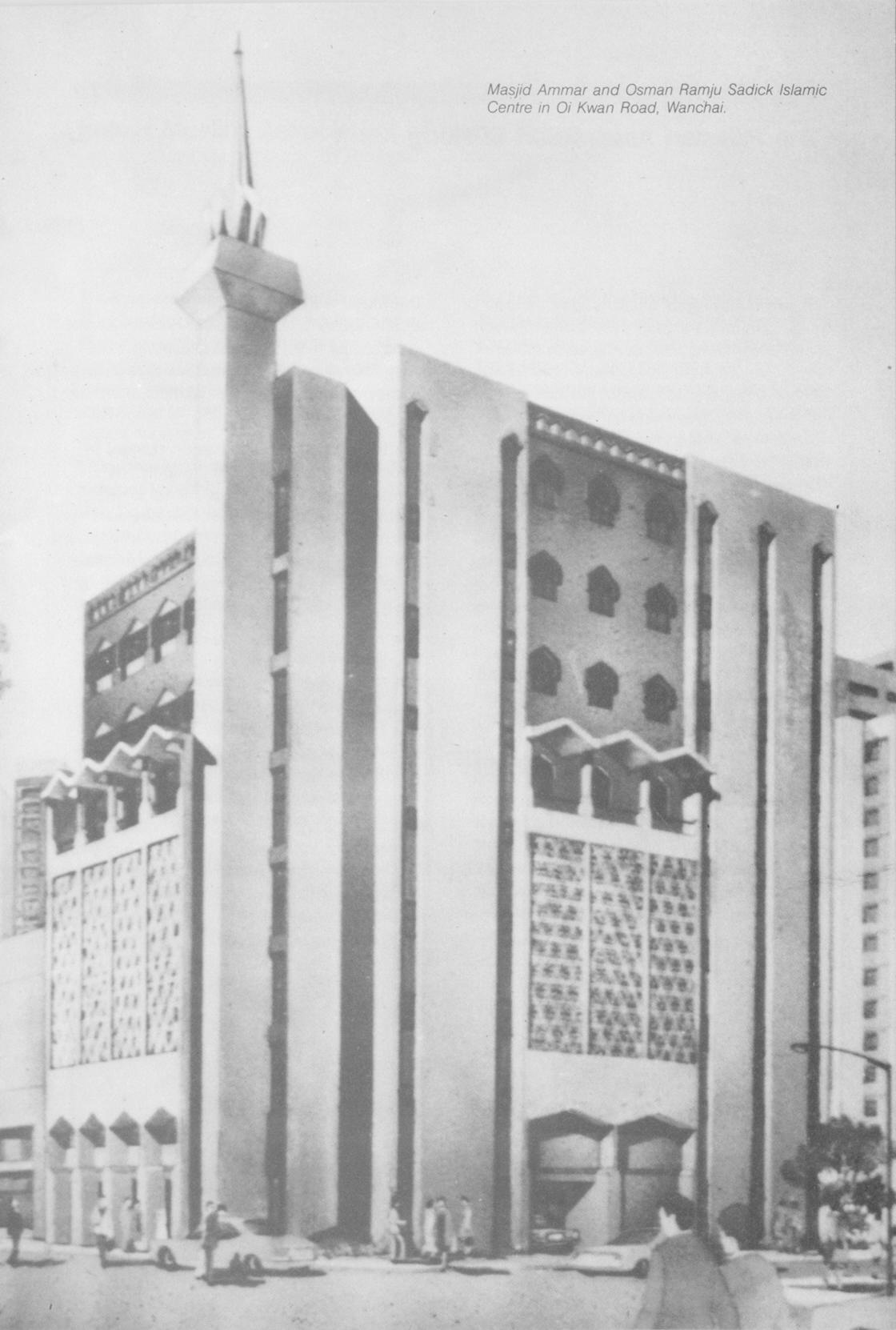
The Islamic Union, after having registered its Medical Clinic with the Government, was able to set up a dispensary of its own to provide medicine for patients. A nominal fee of HK$10.00 is charged for each consultation, including medicine. This fee, however, is waived for all elderly residents at the hostel and those brothers and sisters who cannot afford it. Apart from this facility, the Union also provides medical attention in other areas such as Cardiogram and Dental checks for Muslims requiring this service. The Medical Clinic is served by Muslim doctors and nurses on a voluntary basis.
The Islamic Union's library has on its shelves a total of 2,716 books bearing 1,532 book titles dealing with various subjects of interest, such as Al-Qur'an, Al-Tawhid, Al-Fiqh, Shari'ah, Islamic Laws and Jurisprudence, economics, politics etc. Besides these, there are books on memoirs and biographies of our Holy Prophet Muhammad (S.A.W.) and Islamic writers and scholars. In addition to these, the library also provides books for children to assist them, with the help of their parents and guardians, to acquire basic Islamic knowledge on Iman, Ibadah, Salah and books on the life of our Holy Prophet Muhammad (S.A.W.). Islamic books and literature and also made available to readers who are well versed in the Urdu, Tamil, Korean, Japanese, Malay and Arabic languages.
The Islamic Union is always endeavoring to increase its stock of books on Islam for its library by way of purchases or through the acquisition of free contributions from overseas. The Islamic Union takes this opportunity to appeal to readers to assist in this regard.
The Islamic Union's Youth Section took an active part in promoting youth activities in close liaison with the Hong Kong Islamic Youth Association which has its own office in the same building. Together, the two organizations arranged for Usrah (study) classes, outings, propagation of Islam and camps for the young.
The working arms of the Islamic Union also extend to Macau, the Portuguese-administered territory located about 65 kilometers west of Hong Kong where there was a Muslim population of about 400 up to 1955. After this date, the figures diminished considerably due to migration. The number of Muslims now remaining in the territory is estimated to be around 50.
The Portuguese territory has a small masjid and cemetery managed by the Macau Muslim Association. Recently the Islamic Union assisted the Association to be legally established so as to enable it to look after the interests of the Macau Masjid and Cemetery and the local Muslim community. Furthermore, to encourage the Macau Muslims to propagate Islam in Macau, the Union donated a sum of HK$65,000 to the Association for renovation and repair works to the masjid and a further sum of HK$43,000.00 to cover other types of expenditure.
The declared aim of the Islamic Union of Hong Kong is to propagate Islam and improve the general welfare of Muslims in Hong Kong. We thank Allah that we have been able to pursue this Ideal in a satisfactory manner and pray for his blessings and guidance so that we may continue to do so in the future.
Indian Muslim Association of Hong Kong
It is part of Hong Kong history that the Indian Muslims were in Hong Kong as a division of the British Army at the time of the founding of the Colony in the 19th century. They were followed by and augmented in numbers by the arrivals of traders soon after.
It was mainly for their religious worship that mosques were built in Tsim Sha Tsui and Ho Man Tin on the Kowloon Peninsula and Stanley on the Hong Kong Island, while the Jamia Masjid at Shelley Street was built by an Indian businessman and philanthropist from Bombay, Haji Mohammed Eshaq in 1905.
The partition of the Indian sub-continent in 1947 all but obliterated this small, active and illustrious Indian Muslim Community, at least on paper and in statistics, since most of these Muslims acquired a new nomenclature with the establishment of a new Muslim Nation.
The Indian Muslim Community was reborn in the mid-fifties with the arrival of more Muslim traders from the Indian Republic as well as from Indochina, Singapore, Malaya (now Malaysia), Ceylon (now Sri Lanka), Burma etc. The beginning of the 60s saw the nucleus of these Muslims, most of them settling down in the Tsim Sha Tsui district and a few of them in Happy Valley area on the Hong Kong Island.
These Muslim businessmen with international dealings were conservative and orthodox by nature. They arranged activities such as the conducting of Rathib, Zikr and Maulud; the initiating of the recital of the entire Holy Qur'an at Taraweeh prayers by eloquent Hafiz; the arranging of Iftar during the whole month of Ramadan in conjunction with the local Chinese, Pakistani and Sri Lankan Muslims, contributed in attracting more Muslims to visit the Mosque more frequently. Two learned Imams, Moulvi Haji Yusuf Baquavi (the present Imam) and Haji Syed Yasin Moulana (who passed away in H.K. in 1981) were brought down from India, to lead the five times daily prayers, to hold Qur'anic classes for children and to deliver Tarjumathal Qur'an, Hadith, Bayaan etc. Initiatives were also taken in organizing the celebration of the birthday of the Holy Prophet Muhammad S.A.W., and in arranging Eid gatherings.
When the idea of reconstructing the Kowloon Mosque was mooted, the Indian Muslims took major part in this noble cause through the Kowloon Mosque Reconstruction Committee and the Fund Raising Committee; they also contributed generously and wholeheartedly to this cause, individually and collectively. They were also instrumental in collecting substantial funds from various Middle Eastern Countries.
All this time, the Indian Muslim community did not have any formal organization of their own. Many were in fact, members of the Islamic Union of Hong Kong. But soon the occasion arose for such an official body and THE INDIAN MUSLIM ASSOCIATIQN (JAMAATH) LIMITED was founded and incorporated under the Companies Ordinance in September 1979 as a non-profit making organization. The contribution of the Indian Muslims to the cause of Islam in Hong Kong was duly recognized by brother Muslims and were honoured by being invited to join the Board of Trustees of the Incorporated Trustees of the Islamic Community Fund of Hong Kong.
The main objectives of the Indian Muslim Association are: To promote Islamic Brotherhood among all Muslims of Hong Kong and abroad; to unite and promote better understanding among the Muslims of Indian origin; to promote Brotherhood with all Indians in Hong Kong and abroad; to assist and co-operate with other organizations like the Incorporated Trustees of the Islamic Community Fund of Hong Kong, the Islamic Union of Hong Kong etc.; to lend support to all Islamic bodies on religious and educational matters; to help the needy people in distress from natural causes or otherwise whatsoever and wheresoever regardless of colour, religion or nationality; to promote Islamic and other modern teachings among Muslims; to help set up schools etc., and to help establish scholarship funds for studies wheresoever; to set up free or subsidized clinics for all Hong Kong people; to hold Eid celebrations and any other Islamic functions.
The affairs of the Indian Muslim Association are managed by the Governing Committee which consists of 15 members: a President, three Vice-Presidents, an Honorary Secretary, an Honorary Assistant Secretary, an Honorary Treasurer and 8 other Committee members who are elected annually. The Governing Committee meets once a month to plan, deliberate and execute its stated objectives. The Association, though young, has proved itself once and again to be one of the main pillars of the entire Muslim community of Hong Kong, and will continue to extend its support for the welfare of the Muslims at all times.
Mention must also be made of all local Muslims, as well as Muslims from Pakistan and Sri Lanka, who have stood shoulder to shoulder in all activities in which the Association has been involved in, without any difference or reservations, proving that Islam does not recognise man-made national boundaries and that our Brotherhood is universal. Thus the Indian Muslims have become an indivisible part of the Hong Kong Muslim Community and will strive with other bretheren for the betterment of Muslims, the propagation of Islam and above all, for maintaining the unity of the Brotherhood. Insha Allah.
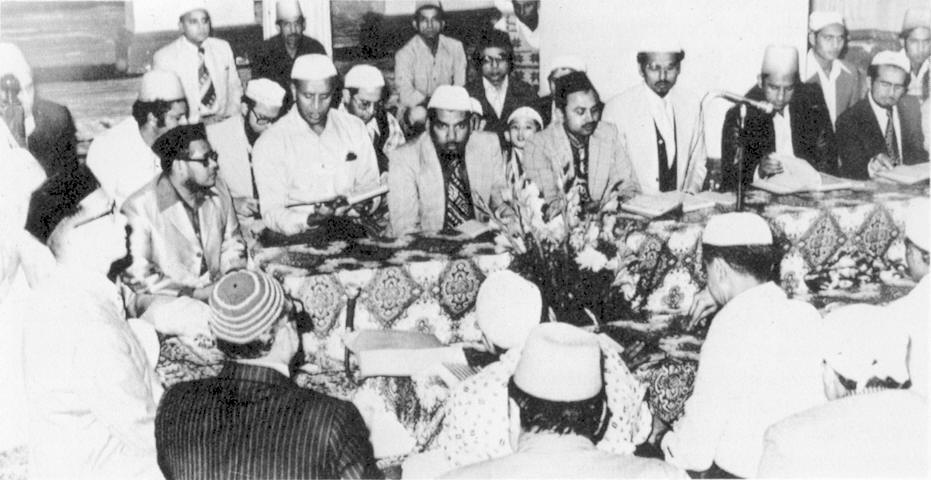
The Longest Serving Chinese Imam in Hong Kong
Haji Maulvi Imam Ahmed Cheung Kwong Yee is no stranger to the local Muslim community. He has been an Imam in Hong Kong for over forty years and is still active in this role.
Born in Hong Kong, Imam Cheung left to study in Guangzhou at the tender age of seven. He attended the Guangzhou Islamic Primary School (約睲痷厩). At the age of fourteen Imam Cheung started to study Arabic and further pursued his studies in Islam under the tutelage of a scholarly and learned teacher - Brother Usman Ma Shiu To. Brother Usman was the teacher and adviser of many of the Imams in Guangzhou.
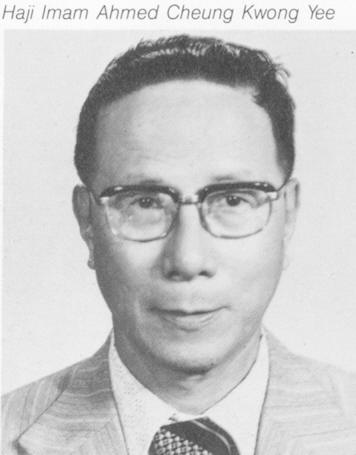
At the age of fifteen, the young Brother Cheung had already set his mind on training himself to be an Imam. This comes as no surprise if one realizes that both his father and grandfather were Imams in Guangzhou.
In those days there were five main masjids in Guangzhou. One of these was the Ho Boon Masjid (花痐睲痷). At the age of eighteen Imam Cheung was one of the two appointed Muezzins at this masjid. At the same time he was invited by the policemen from the Indian subcontinent and stationed in Guangzhou to lead their Juma'a and Eid prayers. It was through such experience that Imam Cheung picked up the Urdu language.
Around 1939 Imam Cheung returned to Hong Kong at the Invitation of the Chinese Muslim Cultural and Fraternal Association (the "Association"). Imam Cheung was to take over from Imam Ibrahim Hung who had left to further his studies at Al Azhar University In Egypt. Thus Imam Cheung began his career as an Imam in Hong Kong.
Imam Cheung started teaching regular classes on Islam. During the Japanese occupation the classes stopped but Imam Cheung remained in Hong Kong to offer his services to the local Muslim community.
With the occupation over, he resumed a more active role in his work. He also engaged in the business of selling household commodities. Now at the age of 72 and with his five sons all grown up and married, Imam Cheung is devoting his full time and attention to being an Imam.
He recalls - in reminiscing by-gone days - the times when talks on Islam at the Association were so well attended that there was hardly any standing room. Not without a tinge of disappointment, he notes that nowadays such talks are less enthusiastically attended.
In 1949 the Imam at Jamia Masjid (Imam Syed Mohammed Noor Shah) left Hong Kong and Imam Cheung became Imam of the masjid.
Imam Cheung has written a number of books on Islam. The books are in the Chinese language and include such titles as The Truth About Islam and Fasting. He has also written books on Islam for use in primary schools. At present Imam Cheung is preparing the publication of his latest book on Islam which will be in the Arabic, Chinese and English languages.
Imam Cheung has taught many devotees how to read the Qur'an. His efforts in this direction continue even today.
At present there are two other Imams apart from Imam Ahmed Cheung Kwong-yee, serving the main masjids on Hong Kong Island and Kowloon peninsula. They are Imam Haji Yusuf Baquavi, an Indian presently the Imam of Kowloon Mosque and Islamic Centre and Abdul Wahab Pau Shing-lai, Imam of Masjid Ammar and Osman Ramju Sadick Islamic Centre.
The late Mohamed Noor Shah was the first Imam in Jamia Masjid in Shelly Street, Central District. During World War I he came to Hong Kong as a "military Imam" with the 2nd Punjab Regiment. After one year, he left the army and stayed in Hong Kong when he was engaged by the Board of Trustees. He was appointed the Imam of Masjid Jamia until he retired in 1945. Together with his family he returned to Rawalpindi in Pakistan. He died in 1980 at the age of 86. The late Imam was well known for his Arabic calligraphy and skill in making Turkish-style praying caps to give as gifts to Muslims passing through Hong Kong from China.
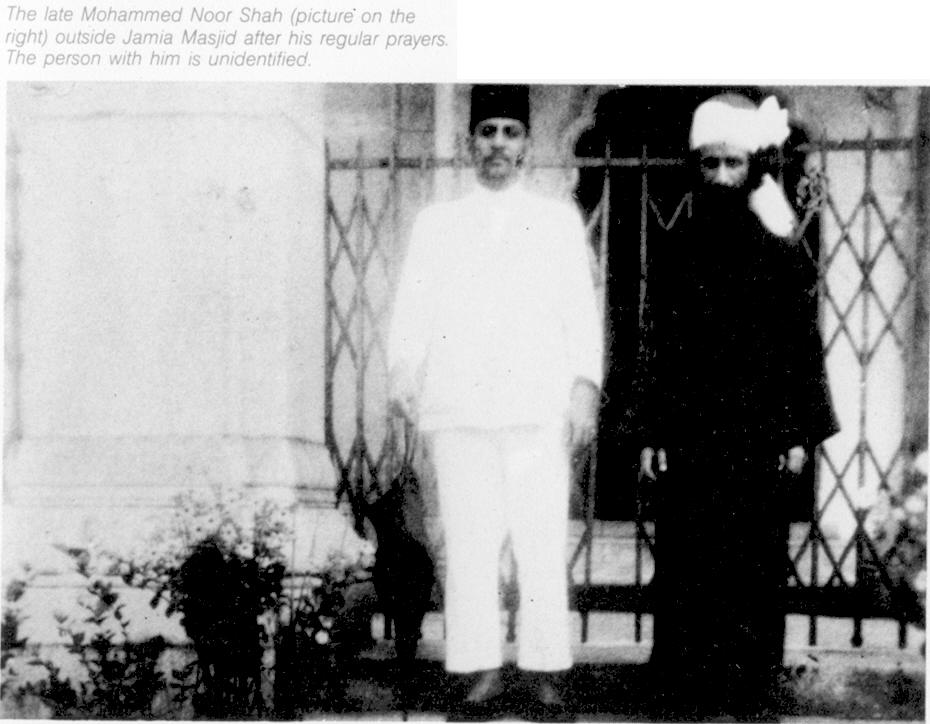
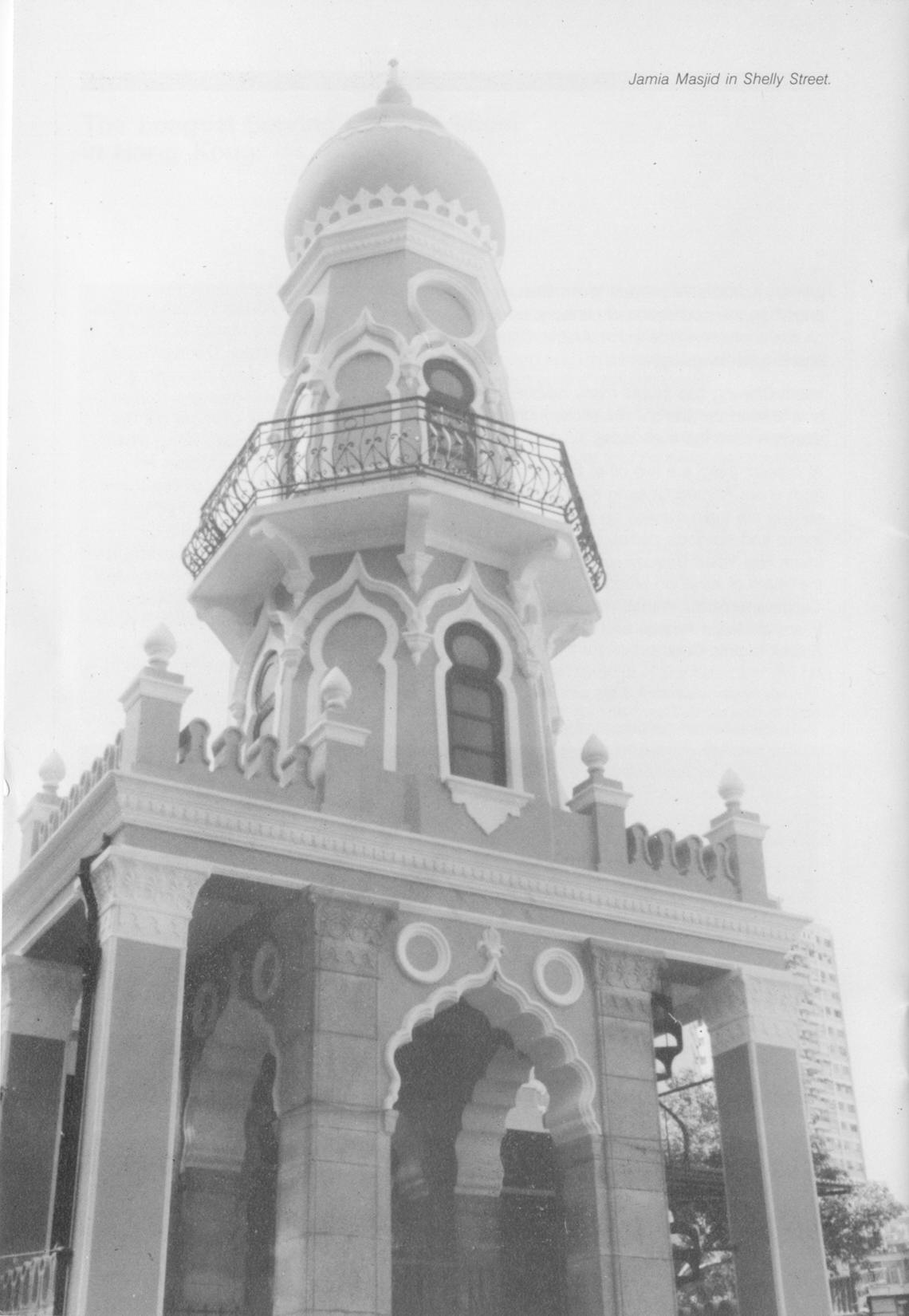
~ The End ~


